Standard and Common Voltage Levels in the US and CA – NEC
Types of Common Electrical Service and Voltage with Configuration Systems in North America
The United States has some of the most complex voltage levels for both residential and commercial applications compared to EU and IEC countries. Basic household voltage in the US is 120V/240V, whereas most IEC countries, including the UK, EU, AUS, and NZ, use a simple 230V single phase and 400-415V three-phase voltage for domestic and small-scale commercial applications.
In addition to 120V single phase voltage, larger electrical systems such as industrial equipment and large commercial buildings may require higher voltages, typically 208, 240, 347, 377, 480, 600 volts, or even more.
In today’s post, we will show the different types of voltage levels used for industrial and residential applications in the US, Canada, and some other countries following the NEC, CNC or similar reginal codes.
Classification of Voltage Levels and Services
Prior to beginning this article, it is important to note that the power distribution systems in the US utilize the following configurations for various voltage levels.
Supply Frequency in the US
- 60 Hz
No. of Phase:
- Single Phase
- Split Phase
- Three Phase
Phase Configuration:
- Wye with Neutral (Star or Y)
- Delta – Generally, Neutral is not available ( Δ)
No. of Wires (Ground Wire is not included)
- 2, 3 or 4.
Voltage Classes according to NSI C84.1-2016
- LV = Low Voltage: <1000 V
- MV = Medium Voltage: >1kV & <100 kV
- HV = High Voltage: >100 kV & ≤ 230 kV
- EHV = Extra-High Voltage: >230 kV but <1000 kV
- UHV = Ultra-High Voltage: ≥1000 kV
Voltage Levels in the United States
120V
The standard voltage in the US is 120 volts – 60 Hz single phase supply. This voltage is used for most household and commercial electrical systems, including outlets, appliances, and lighting. The configuration used for the power distribution is known split phase, Edison system or center-tapped where the secondary of the transformer is split in center to provide two level of voltages i.e. 120V and 240V AC.
The single phase 120V AC in the US and Canada is typically available from the secondary of center-tapped transformer while it can be utilized in the following configurations as well.
120V/240V, Split-Phase – Center-tapped
- 120V AC – 1-Φ = Any One Hot (L1 or L2) + Neutral Wire + Ground Wire
120V/208V, 3-Phase – Wye
- 120V – 1-Φ = One Hot + One Neutral and Ground wire.
120V / 208V & 240V, High Leg – Delta
- 120V – 1-Φ = One Hot + One Neutral and Ground wire.
208V
208 volts is a voltage commonly used in the US for commercial and industrial applications. It’s typically used for three-phase power systems, which are used to power larger equipment and machinery.
208-volt circuits are designed to handle the increased electrical load required by these systems, and they are often found in commercial and industrial buildings, such as factories, warehouses, and office buildings.
Keep in mind that 208V is available for both single phase and three phase voltage levels as follows:
120V/208V – Wye
- 208V – 1-Φ = Two Hot and Ground wire.
- 208V – 3-Φ = Three Hot wires and Ground wire.
120V / 208V & 240V, High Leg – Delta
- 208V – 1-Φ = One High Leg Delta + Neutral and Ground wire.
277V
277 volts is a high voltage commonly used in the US for commercial and industrial applications. This voltage is typically used for lighting (e.g. troffers) and other electrical systems that require a higher voltage than the standard 120 volts used in residential applications.
277V AC is available in 277/480V commercial supply where the three transformers are connected in Wye configuration. The available 277V is as follow:
277V/ 480V – Wye
- 277V – 1-Φ = One Hot + Neutral and Ground wire.
240V
In the US, 240 volts is a higher voltage than the standard household voltage of 120 volts. It’s typically used for larger appliances, such as electric ovens, dryers, water heaters and air conditioners, as well as for industrial equipment and large commercial buildings.
240-volt outlets and circuits are designed to handle the higher wattage rated electrical load required by these appliances and systems. The same split phase (AKA center-tapped or Edison system) is used to obtain the 240V split phase supply. The common configuration systems where 240V (single phase and three phase) are available are as follows:
120V/240V, Split-Phase – Center-tapped
- 240V AC – 1-Φ = Two Hot (L1 & L2) + Ground Wire
120V / 208V & 240V, High Leg – Delta
- 240V – 1-Φ = Two Hot Wires + Ground wire.
- 240V – 3-Φ = Three Hot Wires including Wild Leg + Ground wire.
480V
480 volts is a high voltage commonly used in the US for commercial and industrial applications. This voltage is typically used to power large equipment, such as motors, pumps, and compressors, as well as for lighting and other electrical systems that require a higher voltage than the standard 120 volts used in residential applications.
A voltage level of 480V AC for both single phase and three phase can be achieved through various wiring configurations as follows.
277V/ 480V – Wye
- 480V – 1-Φ = Two Hot wires + Ground wire.
- 480V – 3-Φ = Three Hot wires + Ground wire.
480V / 415V & 240V, High Leg – Delta
- 480V – 3-Φ = Three Hot wires including high leg delta+ Ground wire.
480V-480V-480V – Delta
- 480V – 3-Φ = Three Hot wires + Ground wire.
480V-480V-480V and 277V – Wye
- 480V – 3-Φ = Three Hot wires + Ground wire.
480V (B-Phase Corner Ground) – Delta
- 480V – 3-Φ = Three Hot wires (A-B, B-C & C-A) + Ground wire.
347 & 600
347V and 600V AC voltage levels are less common in the US while easily available in Canada. These voltage levels are used primarily in commercial and industrial applications, and are not typically used in residential settings.
347V AC is a single-phase voltage level commonly used in commercial lighting applications such as high-intensity discharge (HID) lighting systems, metal halide and high-pressure sodium lamps.
600V AC is a common voltage level used for three-phase power distribution in industrial settings. It is typically supplied by a transformer that steps down the distribution voltage, which is typically 7.2k-14kV or 25kV AC, to the lower 600V AC level. This voltage level is used to power a variety of equipment, including motors, pumps, and other heavy machinery.
347V and 600V are available in the following configuration.
347V / 600V – Wye
- 347V – 1-Φ = One Hot Wire + Ground wire.
- 600V – 3-Φ = Three Hot Wires + Ground wire.
Related Posts:
- How To Wire a Single Phase kWh Meter? 120V/240V & 230V AC – NEC & IEC
- How to Wire a Three-Phase Meter? 400V & 120/208/240/277/347/480/600V – IEC & NEC
Electrical Services Configuration in North America
120V/240V, Split-Phase, 3-Wires – Center-tapped
The split-phase system, also referred to as the center-tapped or Edison system, is the most commonly utilized power distribution system in North America, including Canada and the US, specifically in residential applications. The typical configuration for household power supply in the United States is as follows:
- 120V Single Phase = 2 – Wires = 1 Hot + 1 Neutral wire & Ground wire
- 240V Single Phase = 2 Wires = 2 Hot wires & Ground wire
120V/208V, 3-Phase, 4-Wires – Wye
In Three Phase Four Wire Wye, 208V both single phase and three phase with an additional of 120V 1-phase voltage is used for commercial applications. It can be derived from Wye-Wye, Delta-Wye or High leg delta configuration of primary and secondary windings of the transformer. The voltage levels and corresponding wire configurations are as follows:
- 120V Single Phase = 2 – Wires = 1 Hot + 1 Neutral and Ground wire.
- 208V Single Phase = 2 – Wires = 2 Hot and Ground wire.
- 208V Three Phase = 3 – Wires = 3 Hot wires and Ground wire.
120V/208V & 240V, High Leg – 3-Phase, 4-Wires – Delta
In Three Phase Four Wire Delta power distribution system, three wires plus neutral (3-Phase, 4-wires Delta – 4WD) configuration is used in transformers for commercial application to provide various types of voltage levels. The center-tap is used to create a neutral to use with single phase voltage i.e. 120V using either Hot A or Hot B with Neutral wire. The voltage levels and corresponding wire configurations are as follows:
- 120V Single Phase = 3 – Wires = 1 Hot + 1 Neutral and Ground wire
- 208V Single Phase = 3 – Wires = 1 High Leg Delta Hot + 1 Neutral and Ground wire
- 240V Single Phase = 3 – Wires = 2 out of Phase Hot wires and Ground wire.
- 240V Three Phase = 4 – Wires = 3 out of Phase Hot wires including High Led Delta and Ground wire.
In 3-P, 4W Delta, i.e. 120V, 208V, and 240V systems (both 1-phase and 3-phase high leg delta wiring configurations, the main breaker panel provides the following voltage levels:
- Voltage between a hot wire (excluding high leg delta) and neutral: 220V – 1-Φ
- Voltage between the high leg delta hot wire and neutral: 208V -1-Φ
- Voltage between any two hot wires: 240V – 1-Φ
- Voltage between the three hot wires (hot 1, hot 2 (high leg delta), and hot 3): 240V – 3-Φ
Related Post: How to Wire 240V, 208V & 120V, 1 & 3-Phase, High Leg Delta Main Panel?
277V/ 480V, 3-Phase, 4-Wires – Wye
In Three Phase Four Wire Wye power distribution system, three wires plus neutral (3-Phase, 4-wires Wye- 4WY) configuration is used in transformers for industrial and commercial application to provide various types of voltage levels. 277V single phase is used for lighting and plug load while 480V is used for HVAC The voltage levels and corresponding wire configurations in this system are as follows:
- 277V Single Phase = 3 – Wires = 1 Hot + 1 Neutral wire & Ground wire
- 480V Single Phase = 3 Wires = 2 out of phase Hot wires & Ground wire
- 480V Three Phase = 4 Wires = Three out of Phase Hot wires + 1 Neutral wire + Ground wire.
Related Post: How to Wire 277V & 480V, 1-Phase & 3-Phase, Commercial Main Service Panel?
347V/ 600V, 3-Phase, 4-Wires – Wye
This is the same configuration used for 277V/480V. The four wires (3 Hot + Neutral + Ground) is used in subpanels, main distribution panels, load canters and equipment while the three wires (3 Hot + Ground) is used in service entrance and meter cabinet. In wye configuration, the 347 & 600V AC are obtained as follow.
- 377V Single Phase = 2 Wires = 1 Hot wire + Neutral & Ground wire
- 480V Three Phase = 3 Wires = Three Hot wires + Ground wire.
400V/480V/600V, 3-Phase, 3-Wire – Delta
The three phase three wire delta is commonly used for utility power distribution and high load appliances such as large three phase electric motors in the industrial and commercial applications. The typical nominal voltage level used in this configuration are 240V, 400V, 480V, 600V and more according to the design and requirement. For instance, the voltage level in 3-phase, 3-wire delta are as follows:
- 480V Single Phase = 2 Wires = 2 Hot wires & Ground wire (line to line).
- 480V Single Phase = 2 Wires = 1 Hot wire (+ if properly grounded to single point or earth) & Ground wire.
- 480V Three Phase = 3 Wires = Three Hot wires & Ground wire.
480V – 3-Phase, 2-Wire – Corner Grounded – Delta
The three phase two wire corner grounded delta is the same as typical delta configuration and rarely used in the recent systems. It is used to reduce wiring expenses by utilizing a service cable that has only two insulated conductors instead of the three insulated conductors typically required in a conventional three-phase service entrance. In short, only two hot wires are used with neutral (as common grounded – mostly B wire – colored as gray or white) to reduce the wiring cost while achieve and utilize the required power supply. This system is configured from 3-Phase, 4-Wire into 3-Phase, 2-Wire as follow.
- 480V Single Phase = 2 Wires = 1 Hot wires & Neutral grounded wire.
- 480V Three Phase = 2 Wires = Two Hot wires & Ground wire (A-B, B-C or C-A).
Table of Electrical Distribution Systems in North America
The following table shows the Line to Line and Line to Neutral voltage levels in the US and CA for single phase and three phase system in both Wye and Delta (Y & Δ) configuration.
| Line to Neutral Voltage in Wye (Y) | Line to Line Voltage in Wye or Delta (Y & Δ) |
| 120V | 208V |
| 120V | 240V |
| 240V | 415V |
| 277V | 480V |
| 347V | 600V |
The following table shows the electrical power supply and distribution systems in the United States and Canada.
| Configuration | L to N (1-Phase) | L to L (3-Phase) | Countries | Wye or Delta Voltage (Y- Δ) |
| 120V – 1-Φ, 2-Wire + Neutral | 120V | – | US | 3Y-208V |
| 208 V – 1-Φ, 2-Wire (No Neutral) | – | 208V | US | 3D-240V |
| 240V – 1-Φ, 2-Wire (No Neutral) | – | 240V | US | 3D-240V |
| 120V/240 V – 1-Φ, 3-Wire | 120V | 240V | US | 3Y-208V |
| 208 V Delta – 3-Φ, 3-Wire (No Neutral) | – | 208V | US | 3D-240V |
| 480 V Delta – 3-Φ, 3-Wire (No Neutral) | – | 480V | US | 3D-480V |
| 600 V Delta – 3-Φ, 3-Wire (No Neutral) | – | 600V | US, Canada | … |
| 208Y/120V- 3-Φ, 4-Wire | 120V | 208V | US | 3Y-208V, 3D-240V |
| 480Y/277V – 3-Φ, 4-Wire | 277V | 480V | US | 3Y-480V, 3D-480V |
| 600Y/347V – 3-Φ, 4-Wire | 347V | 600V | US, Canada | 3Y-600V |
| 120/208/240V – 3-Φ, 4-Wire High Leg Δ | 120V, 208V | 240V | US | 3D-240V |
| 240/415/480V – 3-Φ, 4-Wire High Leg Δ | 240V, 415V | 480V | US | 3D-480V |
| 208/240V – 3-Φ Corner-Grounded Δ | – | 240V | US | 3D-240V |
| 415/480V – 3- Φ Corner-Grounded Δ | – | 480V | US | 3D-480V |
Main Points
In the US, there are several levels of available voltage for electrical systems, each with its own specific applications and requirements. The most common levels of voltage include:
- 120 Volts – This is the standard household voltage used for most residential applications, including lighting and small appliances.
- 208 Volts – This voltage is commonly used for commercial and industrial applications, such as three-phase power systems used to power larger equipment and machinery.
- 240 Volts – This voltage is commonly used for larger appliances, such as electric ovens, dryers, and air conditioners, as well as for industrial equipment and large commercial buildings.
- 277 Volts – This voltage is commonly used for lighting and other electrical systems that require a higher voltage than the standard 120 volts used in residential applications.
- 347 Volts – This voltage level is commonly used in commercial lighting applications such as high-pressure sodium lamps and high-intensity discharge (HID) lighting systems.
- 480 Volts – This voltage is commonly used to power large equipment, such as motors, pumps, and compressors, as well as for lighting and other electrical systems in commercial and industrial buildings.
- 600 Volts – This voltage level is used to power a variety of equipment, including motors, pumps, and other heavy machinery.
Related Posts:
- Difference Between 120V and 240V/230V AC Power Supply
- Why is the Standard Voltage in the US 120V/240V and 230V in the EU?
- Standard Voltage (V) and Frequencies (Hz) Around the World
- Why is the Standard Frequency 60 Hz in the US & 50 Hz in the EU?
- Difference Between 50 Hz and 60 Hz Frequency System
- Advantages & Disadvantages of 50 Hz and 60 Hz Frequency Power Supply
- Difference Between Single Phase and Three Phase Power Supply
- Why 3-Phase Power? Why Not 6, 12 or More for Power Transmission?
- If a 1-Phase Supply is 230V, Why is 3-Phase 400V & Not 690V?
- Difference Between Socket, Outlet and Receptacle
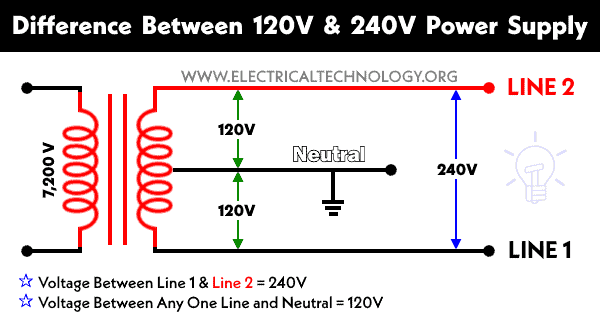
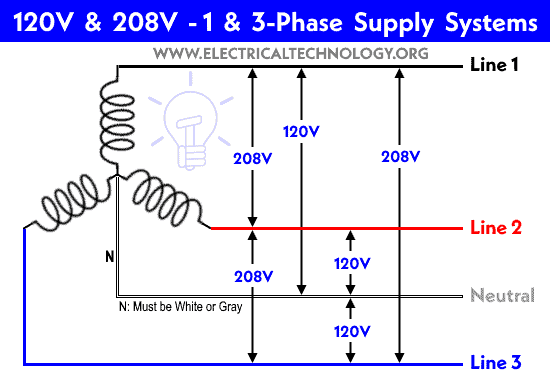
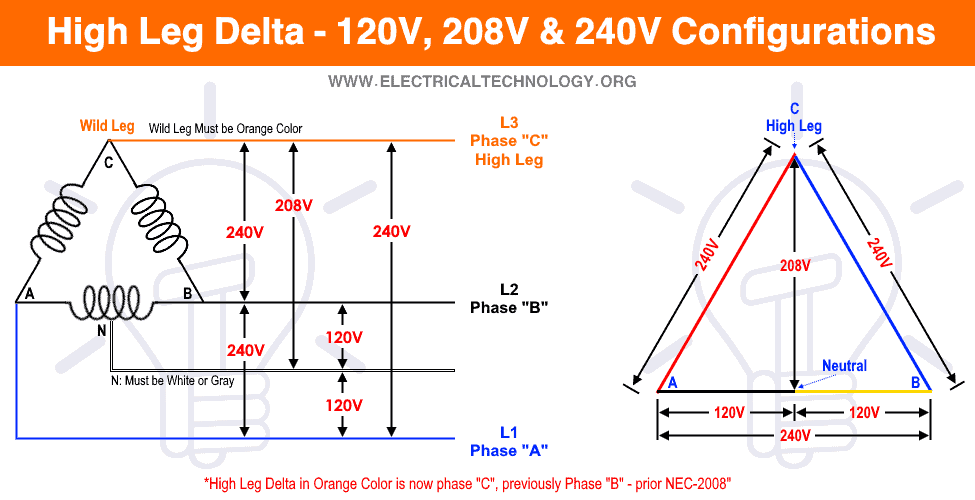
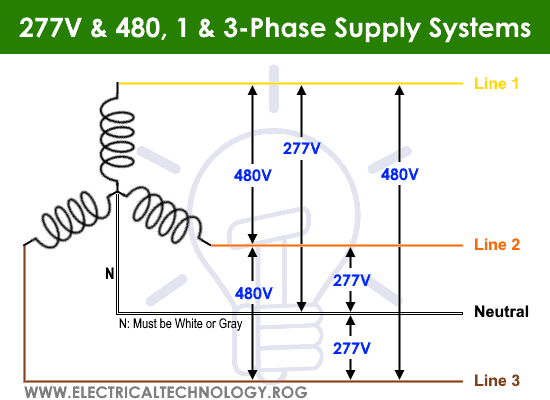
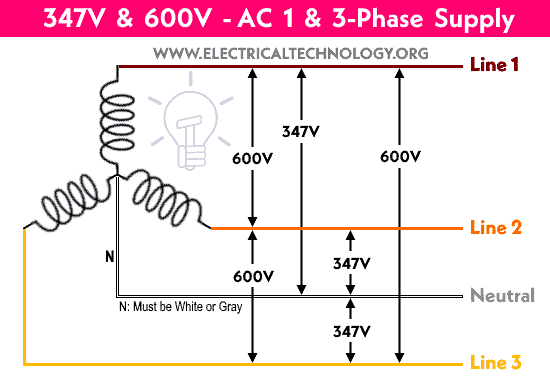
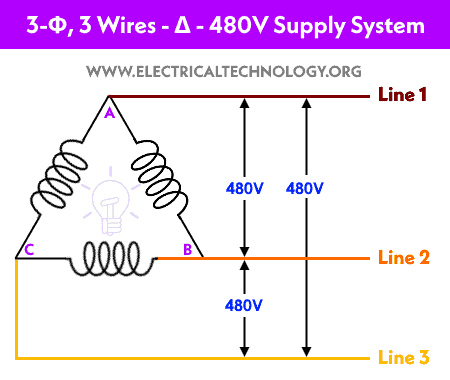








Hello there, everybody! As a resident of New Jersey, I have nothing to offer you but praise for your contribution to educating others about the use of electricity and how to properly use it! Thank you all so much!
Thanks for your kind words and appreciation. Best regards